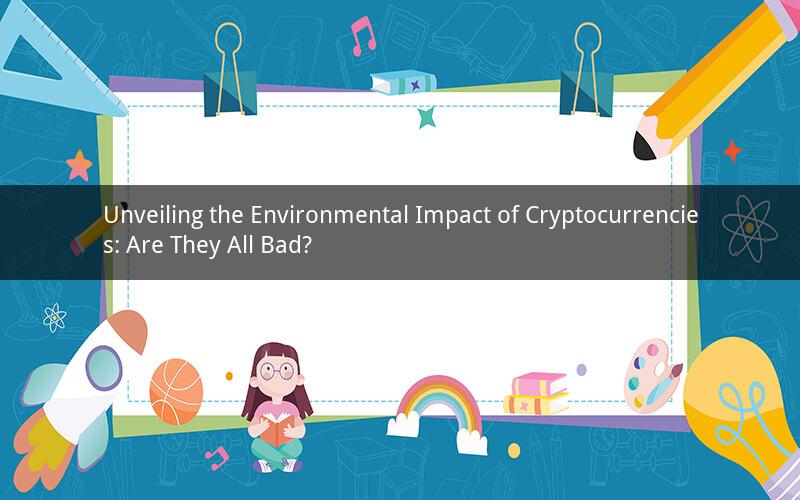
Introduction:
Cryptocurrencies have revolutionized the financial world, offering decentralized and secure transactions. However, concerns regarding their environmental impact have been growing. This article delves into the environmental implications of cryptocurrencies, examining whether they are all bad for the environment.
1. The Energy Consumption of Cryptocurrencies:
One of the most significant environmental concerns associated with cryptocurrencies is their energy consumption. The process of mining cryptocurrencies, particularly Bitcoin, requires a substantial amount of electricity. This has led to debates about whether cryptocurrencies are sustainable in the long run.
Explanation:
Mining cryptocurrencies involves solving complex mathematical puzzles to validate transactions and add new blocks to the blockchain. This process requires powerful computers, known as miners, which consume a significant amount of electricity. The energy consumption of mining varies depending on the cryptocurrency, with Bitcoin being the most energy-intensive.
2. The Carbon Footprint of Mining:
The energy consumption of mining cryptocurrencies has a direct impact on the carbon footprint. The majority of electricity used for mining comes from fossil fuels, such as coal and natural gas, which emit greenhouse gases into the atmosphere. This raises concerns about the contribution of cryptocurrencies to climate change.
Explanation:
The carbon footprint of mining cryptocurrencies is a critical issue. The energy-intensive nature of mining leads to increased carbon emissions, contributing to global warming and climate change. This has sparked debates about the sustainability of cryptocurrencies and their role in environmental degradation.
3. Alternative Mining Methods:
To address the environmental concerns associated with mining, alternative methods have been proposed. Some cryptocurrencies have shifted towards more energy-efficient consensus mechanisms, such as Proof of Stake (PoS), which reduces the need for mining and energy consumption.
Explanation:
In response to the environmental impact of mining, alternative consensus mechanisms like Proof of Stake have gained popularity. PoS eliminates the need for miners to solve complex puzzles, reducing energy consumption significantly. This shift towards more sustainable methods aims to mitigate the environmental concerns associated with cryptocurrencies.
4. The Role of Renewable Energy:
Another approach to address the environmental impact of cryptocurrencies is the adoption of renewable energy sources for mining. By using renewable energy, such as solar or wind power, the carbon footprint of mining can be significantly reduced.
Explanation:
The use of renewable energy sources for mining cryptocurrencies is a promising solution. By harnessing clean energy, the carbon emissions associated with mining can be minimized. This approach promotes sustainability and reduces the environmental impact of cryptocurrencies.
5. The Overall Environmental Impact:
While cryptocurrencies have raised environmental concerns, it is important to consider the overall environmental impact. The energy consumption of mining cryptocurrencies is a fraction compared to traditional financial systems, which rely heavily on paper-based transactions and transportation.
Explanation:
When evaluating the environmental impact of cryptocurrencies, it is crucial to compare them to traditional financial systems. While mining cryptocurrencies does consume energy, the overall environmental impact is relatively small when considering the vast scale of traditional financial operations. Additionally, the potential for cryptocurrencies to reduce paper usage and promote digital transactions cannot be overlooked.
Questions and Answers:
1. What is the primary environmental concern associated with cryptocurrencies?
The primary environmental concern associated with cryptocurrencies is their high energy consumption, particularly in the process of mining.
2. Why is mining energy-intensive?
Mining cryptocurrencies requires powerful computers to solve complex mathematical puzzles, which consume a significant amount of electricity.
3. How does the energy consumption of mining contribute to carbon emissions?
The energy consumed for mining cryptocurrencies often comes from fossil fuels, such as coal and natural gas, which emit greenhouse gases into the atmosphere, contributing to carbon emissions.
4. Are there alternative methods to mining that are more energy-efficient?
Yes, alternative methods like Proof of Stake (PoS) have gained popularity. PoS reduces the need for mining and energy consumption by eliminating the need for miners to solve complex puzzles.
5. Can cryptocurrencies be environmentally sustainable?
Yes, cryptocurrencies can be environmentally sustainable through the adoption of renewable energy sources for mining and the implementation of more energy-efficient consensus mechanisms like PoS. These approaches aim to minimize the environmental impact of cryptocurrencies.
Conclusion:
While cryptocurrencies have raised environmental concerns, it is essential to consider the overall impact. The energy consumption of mining, particularly for Bitcoin, is a significant concern. However, alternative methods and the adoption of renewable energy can mitigate these issues. It is crucial to promote sustainable practices within the cryptocurrency ecosystem to ensure its long-term environmental viability.